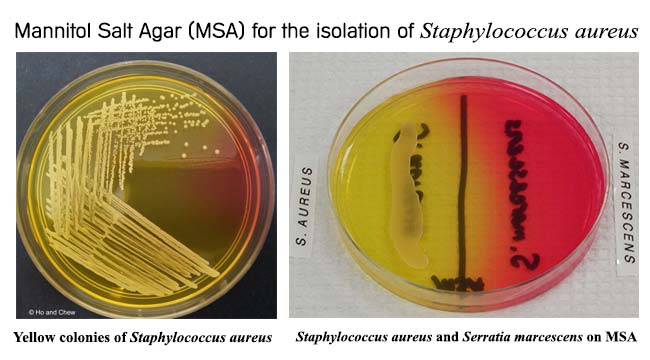Mannitol Salt Agar (MSA) is used as a selective and differential medium for the isolation and identification of Staphylococcus aureus from clinical and non-clinical specimens. It encourages the growth of a group of certain bacteria while inhibiting the growth of others. It is a selective medium prepared according to the recommendations of Chapman for the isolation of presumptive pathogenic staphylococci.
Composition of Mannitol Salt Agar (MSA)
| Ingredients | Gms / Litre |
|---|---|
| Pancreatic Digest of Casein | 5.0 gm |
| Peptic Digest of Animal Tissue | 5.0 gm |
| Beef Extract | 1.0 gm |
| Sodium Chloride | 75.0 gm |
| D-Mannitol | 10.0 gm |
| Phenol Red | 0.025 gm |
| Agar | 15.0 gm |
| Total | 111. 025 gm |
Distilled Water = 1000 ml
Final pH 7.4 ± 0.2 at 25°C.
Principle of Mannitol Salt Agar
Mannitol Salt Agar contains peptones and beef extract, which supply nitrogen, vitamins, minerals and amino acids essential for growth. The 7.5% concentration of sodium chloride results in the partial or complete inhibition of bacterial organisms other than staphylococci. Sodium chloride also supplies essential electrolytes for transport and osmotic balance. Mannitol is the fermentable carbohydrate, fermentation of which leads to acid production, detected by phenol red indicator, aids in the differentiation of staphylococcal species. Coagulase positive staphylococci (e.g., Staphylococcus aureus) produce yellow colonies and a surrounding yellow medium while coagulase negative staphylococci produce red colonies and no color change of the phenol red indicator. Agar is the solidifying agent.
Addition of 5% v/v Egg Yolk Emulsion enables the detection of lipase activity of staphylococci along with mannitol fermentation. The salt clears the egg yolk emulsion and lipase production is detected as yellow opaque zone around the colonies.
Uses of Mannitol Salt Agar
- It is used for the selective isolation and differentiation of Staphylococcus aureus from clinical samples.
- It is also used for the enumeration of staphylococci in food and dairy products.
- This medium is also included in the Bacteriological Analytical Manual for cosmetics testing.
- It is also used in the bacteriological examination of swimming pool water, spas and drinking water using membrane filtration
Preparation of Mannitol Salt Agar
- Suspend 111.025 gm of MRS media in 1000 ml of distilled water.
- Boil to dissolve the media completely.
- Autoclave at 121°C for 15-20 minutes.
(Optional: Add 5% v/v Egg Yolk Emulsion)
- Cool to 45-50°C and pour into petri dishes.
Result Interpretation on Mannitol Salt Agar

| Organisms | Results |
|---|---|
| Staphylococcus aureus | Yellow colonies with yellow zones. |
| Staphylococci other than S. aureus (e.g. Staphylococcus epidermidis ) | Colorless or Red colonies with red zones. |
| Streptococci | No growth to trace growth. |
| Micrococci | Large white to orange. |
| Gram-negative bacteria | No growth to trace growth. |
Quality Control on Mannitol Salt Agar
Positive Control: Staphylococcus aureus ATCC 6538, Medium-sized yellow colonies
Negative Control: Escherichia coli ATCC 25922, Partial to Complete Inhibition.
Limitations of Mannitol Salt Agar
- Several Staphylococcus species other than aureus are mannitol positive and produce yellow colonies surrounded by yellow zones on this medium (e.g. S. capitis, S. xylosus, S. cohnii, S. sciuri, S. simulans, and other species). Therefore, further biochemical tests are necessary for the identification of S. aureus or other species.
- Most organisms other than staphylococci are inhibited by the high salt concentration found in Mannitol Salt Agar except for some halophillic marine organisms.
- A few strains of Staphylococcus aureus may exhibit a delayed fermentation of mannitol. Negative plates should be re-incubated overnight before discarding.
- Presumptive Staphylococcus aureus must be confirmed with a coagulase test.
References
- Mannitol Salt Agar. HiMedia.
- Mannitol Salt Agar (MSA) (Chapman Medium) European Pharmacopoeia, Usp.
- Mannitol Salt Agar. Accumix.
- Mannitol Salt Agar. Biokar Diagnostics – Rue des Quarante Mines – ZAC de Ther – Allonne – B.P. 10245 – F60002 Beauvais Cedex – France.
- Mannitol Salt Agar. Remel.
- Mannitol Salt Agar. PML Microbiologicals, Inc.
- Mannitol Salt Agar. Acumedia Manufacturers, Inc.
- Mannitol Salt Agar. Difco™ & BBL™ Manual, 2nd Edition
- Mannitol Salt Agar. Liofilchem SRL.
- BD Mannitol Salt Agar. Becton Dickinson GmbH.
- Mannitol Salt Agar (MSA). Hardy Diagnostics.
- Mannitol Salt Agar. Dehydrated Culture Media. Thermo Fisher Scientific Inc.
- https://en.wikipedia.org/wiki/Mannitol_salt_agar
Similar Posts:
- List of culture media used in microbiology with their uses
- Coagulase Test- Principle, Procedure, Types, Interpretation and Examples
- Xylose Lysine Deoxycholate (XLD) Agar- Principle, Uses, Composition, Preparation and Colony Characteristics
- Thiosulfate-Citrate-Bile Salts-Sucrose (TCBS) Agar- Composition, Principle, Uses, Preparation and Colony Morphology

Hallo,
My respected sir,
You please tell me… How process can I measurements the antimicrobial sensitivity test of Staphylococcus aureus???
Which process or method can I following for the sensitivity test of Staphylococcus aureus??????
I kindly requested to you, please you response me.
With my respect.
If the organism in MSA ferments mannitol and forms yellow colonies, can we directly assume it as S.aureus or we have to further sub culture in nutrient agar and do biochemical tests? What is the ideal method? Please explain this.
If you find the MSA turned yellow, S. Aureus is there, but it is regarded as presumptive test; one should perform coagulase test too. Streak on NA to adopt pure culture and then perform coagulase test.
sir?
what are the effects of using too much higher amount of MSA with 250ml of distilled water?
Will the cultured specimen still grow